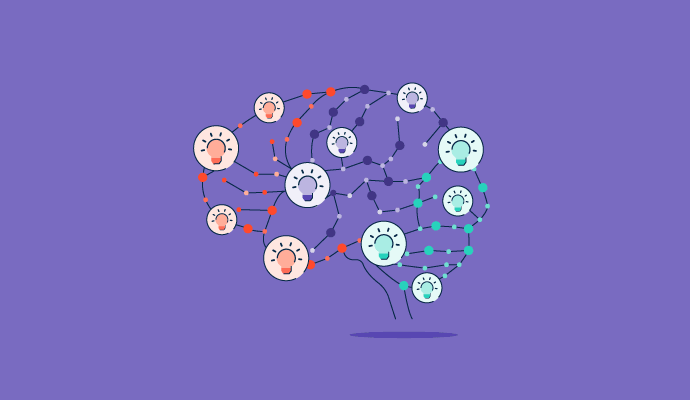
November 4, 2022
 by Aisha West
by Aisha West

Whether you’re working on a creative project or innovating business plans, the beginning of the process often comes with so many ideas and possibilities that they cause a traffic jam in your brain.
Mind mapping, also known as concept mapping or thought mapping, is a visual technique that makes it easier to see and organize your thoughts at the start of your journey.
Based around a single, central theme or central idea, mind mapping lays out intentions so that you understand your thought patterns and discover unexpected connections, keeping your brain’s highway running smoothly. If this seems daunting, don't worry! Mind mapping software is available to help with this.
Mind mapping is a creative thinking method that diagrams and organizes information based on a central theme or central concept, starting with a single word in the middle of a blank page. Ideas or sub-topics associated with this theme are then added to the page as branches and twigs to help offer insight and make associations about the main concept. Think about it as a mapping chart that helps you make sense of your brain's activities!
Diagramming ideas in a visual way has been happening for centuries, but Tony Buzan, a British writer and television host, popularized the term mind mapping on his show “Use Your Head” in 1974. He demonstrated mind maps, using different colors to highlight key words and phrases. The resulting maps often ended up looking like trees, hence the terms “branches” and “twigs”.
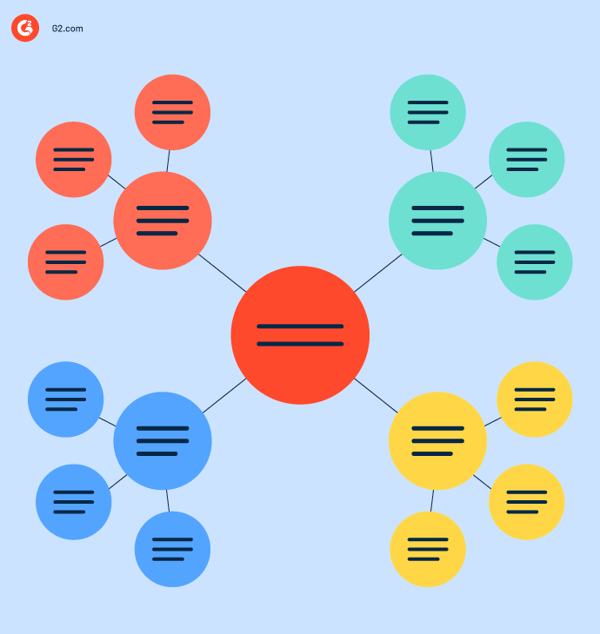
The purpose of a mind map varies. Some use it to improve memory as they study for a test or try to improve memory retention. Those looking to better their understanding of the literature of literary or political concepts often benefit from a mind map.
Writers, either working alone or with a cohort, use mind maps a lot as a brainstorming technique to help defeat writer's block. Marketing teams might like to use it as a way to plan projects, develop a content calendar, or write a sales playbook — you pick. There really are no limitations to what you can use mind maps for.
While other outlining or note-taking techniques start at the top of the page, mind mapping starts in the middle.
To begin a mind map, you first have to come up with a general theme or overarching strategy. What questions are you trying to answer? What problems are you trying to solve?
Suppose you’re a director. You and your team are trying to raise funds for your next independent film. The main theme or center of your mind map would be “funding”.
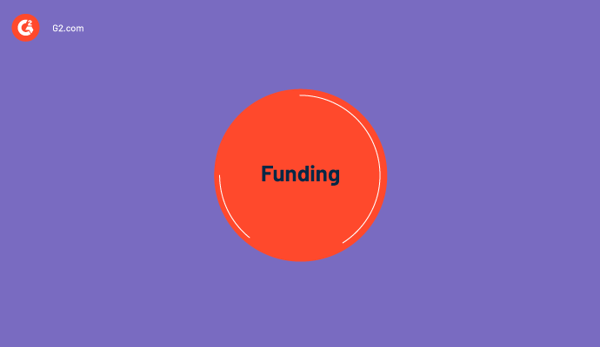
The main branches from the center of the funding mind map will be more specific than the overall map theme. As the director, you will draw branches out from the center and assign them a keyword.
You might decide to brainstorm funding ideas by researching fundraising trends or categorizing different types of funders. In this case, the keywords for these branches could be “friends and family”, “executives”, and “crowdfunding".
It’s important you have clear, concise keywords associated with each branch so you’re able to easily remember how you organized your thought process. Using color is another trick that keeps ideas in order. Mind maps that use color make it easier to stay organized because it splits the map into digestible sections.
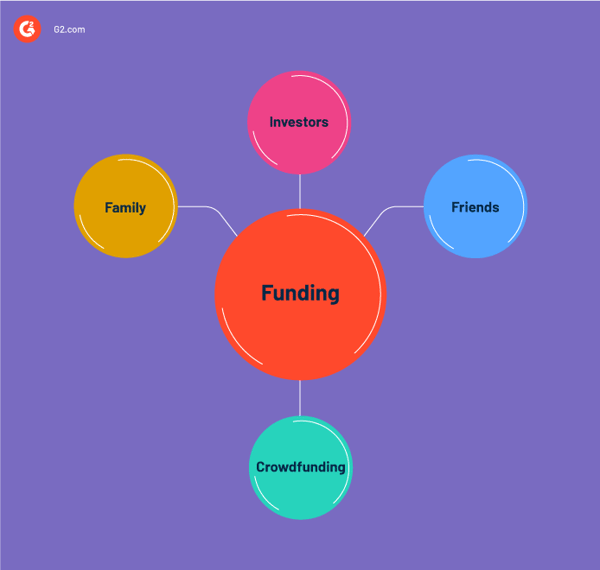
The purpose of a mind map is to start with a general concept and work your way into the nitty gritty. This is where the ideas really start flowing, and where you should feel free to let out anything and everything that comes to mind.
Let’s take the earlier example and focus on the “crowdfunding” branch. You would draw lines out from this branch and start listing what kinds of crowdfunding methods might work for you.
Some of your twigs or sub-branches might be:
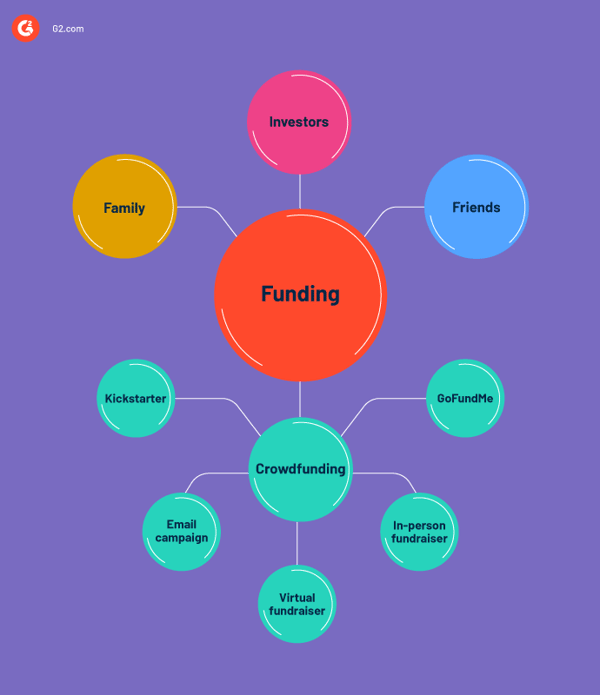
After finishing the twig step of your mind map for crowdfunding, you’ll repeat the process for the remaining branches. Remember to assign branches and twigs concise keywords. A mind map isn’t a place to elaborate on details.
Once you’ve used thought mapping to shake loose as many ideas as possible, you can then create more formal, linear plans for next steps.
For example, now that you have ideas for fundraising, your team members can begin writing copy for your different campaigns. Since in-person and virtual fundraising are also on your map, the next step might be to gather contact information for invitees.
Because it’s your personal mind map, your next steps will look different than any mind map examples from the internet. Yours could even look different than someone using the same main topic. Don’t be afraid to stick with the journey you’ve mapped out.
After working on the crowdfunding mind map above, these are some ideas you might land on.
Topic One: Funding an indie film
There are really just two different types of mind maps that are codified (don’t let this deter you from finding your mapping chart).
First is the mind map we’ve been discussing, with its trunk, branches, and twigs.
Then there's a spider map, developed from the tree metaphor and refers to the way a spider weaves a web. Instead of each branch staying in their own lane, they can cross and interconnect. So the idea about investors might cross over to performers if an investor has a family member who wants to play at the fundraiser.
Even at small businesses, there are people who feel shy about sharing their ideas about projects or improvements. The process of thought mapping attempts to create an environment where everybody feels safe voicing their ideas.
This feeling of support and security that comes with mind mapping can benefit small businesses in a few different ways.
Even if you decide mind mapping isn’t for you, there aren’t that many cons in the process, but a few challenges might arise.
Depending on how your brain works (in general and from day to day {or minute to minute, let’s be honest}), mind mapping could be anxiety-making. Remember that anything goes. Let’s review over the basic steps.
If you’re more linear thinker than tree hugger, consider this:
Stay on motif of our earlier example of a struggling film team:
If this still seems like a mystery:
Mind mapping software gives you the tools to diagram and sort brainstorming sessions, either for individuals or those collaborating. This software deconstructs the thought process into easily digestible bites and helps users find unexpected ideas and solutions.
To qualify for a spot on the mind mapping software grid, a product has to:
* Below are the five leading mind mapping software vendors from G2's Fall 2022 Grid® Report. Some reviews may be edited for clarity.
Miro calls itself “an intuitive and robust mind mapping tool”. More than 20 million users take advantage of Miro’s blank canvas to make and share brainstorming sessions and other creative workshops.
“It is a collaborative tool that allows me to work in a visual format. I am not joking when I say I use it daily, and often for hours each day. It is that integral to my work and how I work with my colleagues.”
- Miro Review, Andy K., May 10, 2022
“The good thing about Miro is the infinite boards that it provides. However, these can sometimes get difficult to manage if you have put a lot of ideas over several sessions. Unless you manage them properly it can get overwhelming to find out what you had worked on previously.”
- Miro Review, Abhishek D., May 10, 2022
Mural is focused on providing teams from all kinds of businesses the means to connect and participate in creating deliverables with a collaborative, digital whiteboard workspace.
“If your requirement is an easy-to-use, intuitive tool that allows teams of all abilities to share ideas, feedback, and training, then this is the go to tool. The post-it note facility is super easy to use; follow-me allows users to follow who is presenting instead of getting lost in a large Mural board.”
- Mural Review, Stephan C., Feb 17, 2022
“I haven't really found a way to apply it to my day to day. I feel like it works better for longer term projects and we have to respond back to clients within 24 hours. Also I feel like the lock feature can be a bit tricky, and sometimes I find it a little confusing on how to decide what to use.”
- Mural Review, Ann F., Nov 18, 2020
Lucidspark is a digital whiteboard with tools like infinite canvas, free draw, breakout boards, and templates. Co-workers can collaborate in real time or asynchronously to make decisions about projects and innovations.
“Lucidspark makes it so easy to collaborate as a team. Rather than having to all get in a room and then take pics of the whiteboard, we are able to collaborate virtually and all have access to the same doc.”
- Lucidspark Review, Tyler H., Apr 26, 2022
“When switching between portrait and landscape, it doesn't realign your work on the page. Formatting in terms of text alterations and such wasn't the most convenient with the user interface currently in place. I would have liked to see a slightly better user interface in terms of overall flow and ease of use as well.”
- Lucidspark Review, Mark H., Jul 10, 2022
Clickup is a fully customizable task management software that brings teammates together on a single app for planning and collaboration.
“Initially, I tried ClickUp because the time tracking and reporting it offered for free had features beyond and above the paid version of the task tracker I was using. After that, I just kept using more features in ClickUp to manage my one-man show. I'm not managing myself and 4 employees and can't imagine doing it without ClickUp.”
- Clickup Review, Tim D., May 10, 2022
“When I go to set up for my business, I get overwhelmed with whether it meets our needs or not. Sometimes just a simple spreadsheet is all that is needed. I wish I could have simplicity of Google Sheets with team chat and some optional integrations as needed.”
- Clickup Review, Phil M., May 12, 2020
Klaxoon is a one-stop shop for leading effective workshops no matter where in the world your team members are. A French company that’s been in business since 2015, Klaxoon offers whiteboards, quizzes, and communication tools.
“Klaxoon helps make team collaboration easy where you can promote remote work in a hybrid working environment. In our organization, we also use Klaxoon to help us in our learning needs to create byte-sized modules and promote user generated content."
– Klaxoon Review, Shashank M. Jun 02, 2022
“The tool requires training to be used to its full potential. It is not always easy to use for someone who is new to it.”
- Klaxoon Review, Yann M., Jun 16, 2022
Experimenting with mind mapping gives you a new way of starting any project that’s challenging you or your teammates. Surprise yourself with the journey your brain has in store for you!
It's always a good time with asynchronous communication! Read up to find out how you and the team can stay connected across space and time.
Spark your team's creativity with the help of the best mind mapping software.
Aisha West is an actress, writer, and Content Editor at G2. After graduating from the Experimental Theatre at Tisch School of the Arts at New York University, Aisha wrote, directed, and performed plays with Synaesthetic Theatre for ten years. She lives in Brooklyn with three tuxedo cats.

Spark your team's creativity with the help of the best mind mapping software.
Ideas are the fuel that drives a business forward.
 by Washija Kazim
by Washija Kazim
Entrepreneurs need financing to keep the momentum going, but asking for money isn’t fun.
 by Sudipto Paul
by Sudipto Paul
What is mind mapping? Mind mapping is the visualization of organized thoughts, ideas, and...
 by Brianna Bajwa
by Brianna Bajwa
Ideas are the fuel that drives a business forward.
 by Washija Kazim
by Washija Kazim
Entrepreneurs need financing to keep the momentum going, but asking for money isn’t fun.
 by Sudipto Paul
by Sudipto Paul
Never miss a post.
Subscribe to keep your fingers on the tech pulse.


